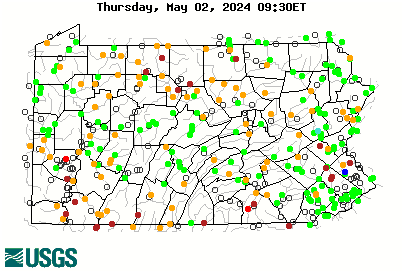Not a science based observation here, but it seems to me trout that get caught a lot end up having their jaws damaged. An example I can give is a 10-inch brown I caught in the slack water up from the Allenberry this spring. It was on a barbless fly. I was able to get a firm hold on the fly and turn it to set the trout loose without touching the fish. I've done this hundreds of times, but this time, a chunk of jawbone came off with the fly.
Possibly it was a bad bit of leverage on my part, but it was clear the trout was no stranger to being hooked. I suspect being caught several times put a few too many holes in the fish's mouth and my hook was the one that finally ripped a piece of jaw loose.
A single bad release can do a lot of damage, but I'm increasingly inclined to believe a lot of tender releases have the same effect as a death by a thousand cuts.
As for the treble hook issue, I'm inclined to agree with Mike that there's a lot of hard opinion out there that isn't backed by science that's similarly hard.
I know a few years back I looked at some of the studies about the best kinds of nets if you want to release fish. I wanted to find the numbers behind the logic of switching to the now standard rubber nets. I found a study called "“Effects of landing net mesh type on injury and mortality in a freshwater recreational fishery" by fisheries biologists working for Florida, Illinois and Canada. It studied the effects of netting on bluegill with 50 bluegill netted with each type of net, plus another 50 hand released:
- None of the fish released by hand died
- Four of the fish landed in the rubber net died
- Six of the fish landed in the knotless mesh net died
- 14 of the fish landed in the finely knotted net died
- 10 of the fish landed in the coarsely knotted net died
In short, the rubber net is better, but hand release is best (based on sunnies and other panfish, not trout). I figured I rarely catch a trout so large that it truly needs to be netted, so I stopped carrying a net and never looked back. It's made me more cognizant of how I play my fish so as to get them in efficiently without the crutch of using a net a the end. (Also, I had to cringe about a year ago when I was at a heavily fished spot and saw guys swinging their 10-inch trout through the air and into nets as though the nets were lacrosse sticks, but that's a different subject.)
There's guys out there who swear by the rubber net, and it is better than knotted mesh nets for fish survival, but that's only part of the story. I'm going to guess the research on treble vs single vs single barbless shows a similar range of results.
The study I cited is at this link (at least the abstract is):
https://www.researchgate.net/publication/228854436_Effects_of_landing_net_mesh_type_on_injury_and_mortality_in_a_freshwater_recreational_fishery#:~:text=Our results indicate that fish,the rubber or knotless mesh




